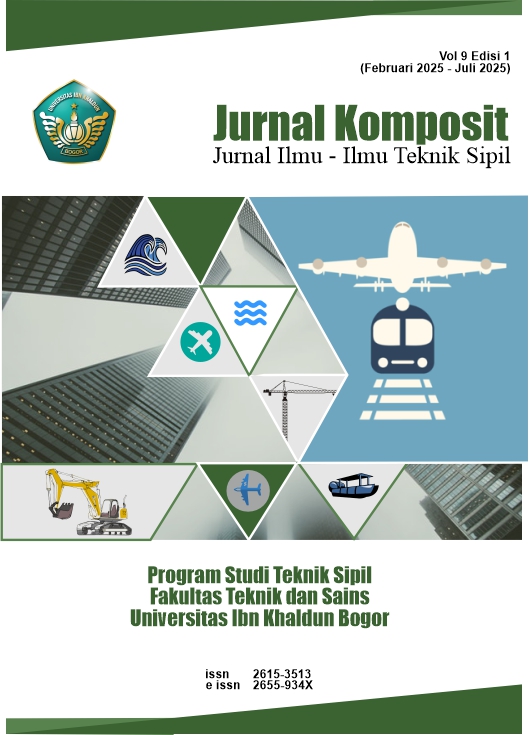The Effect of Coconut Fibre on the Compressive and Tensile Strength of Geopolymer Concrete
DOI:
https://doi.org/10.32832/komposit.v9i1.16456Keywords:
geopolymer concrete, fly ash, tensile strength, compressive strength, coconut fibreAbstract
This research aims to evaluate the impact of adding coconut fiber on the compressive and tensile strengths of geopolymer concrete. The study utilized geopolymer concrete composed of a mixture of fly ash and coconut coir fiber. The research variables included the percentage of coconut coir fiber in the geopolymer concrete mix, namely 0%, 0.25%, 0.50%, and 1%. Data collection involved the fabrication of geopolymer concrete, testing of coarse and fine aggregates, and aggregate sieve analysis. The results of this study are expected to provide insights into the potential of coconut fiber in enhancing the quality of geopolymer concrete. The analysis revealed that the addition of coconut fiber can increase the tensile strength of geopolymer concrete, with a peak enhancement of 32.52% observed at the optimal proportion of 0.5%. Conversely, at 1%, a decrease of 4.64% in tensile strength was noted. Furthermore, the compressive strength of geopolymer concrete experienced improvement up to a proportion of 0.5%, showing an increase of 48.79%. However, at 1%, the tensile strength decreased by 12.43%. Therefore, the 0.5% proportion of coconut fiber is considered optimal for enhancing both tensile and compressive strengths of geopolymer concrete. This research contributes to expanding the understanding of coconut fiber usage in geopolymer concrete and provides recommendations regarding the optimal proportion of coconut fiber in the geopolymer concrete mix.
References
Ardy, R. (2017). Studi Pemanfaatan Serat Serabut Kelapa dengan Variasi Perlakuan Alkali Terhadap sifat Mekanik Beton. Undergraduate thesis, Universitas Atma Jaya Yogyakarta. http://e-journal.uajy.ac.id/id/eprint/13188
Ahmad, W., Farooq, S. H., Usman, M., Khan, M., Ahmad, A., Aslam, F., Yousef, R. A., Abduljabbar, H. A., & Sufian, M. (2020). Effect of Coconut Fibre Length and Content on Properties of High Strength Concrete. Materials (Basel, Switzerland), 13(5), 1075. https://doi.org/10.3390/ma13051075
Dipohusodo, I. (1994). Struktur Beton Bertulang. Jakarta: Gramedia. https://gpu.id/book/77873/struktur-beton-bertulang
Hermansyah, H., Sachroudi, M. R.. (2023). Pengaruh Penambahan Sabut Kelapa Sebagai Material Serat terhadap Kuat Tekan Beton. Jurnal Kacapuri, 6(1), 23 – 34. DOI:http://dx.doi.org/10.31602/jk.v6i1.10997
Murdock, & Brook. (1991). Bahan dan Praktek Beton. (Trans: Stephanus Hindarko). Jakarta: Erlangga. https://perpustakaan.binadarma.ac.id/opac/detail-opac?id=3013
Rohana, E. A. (2022). Pengaruh Penambahan Abu Serabut Kelapa sebagai Pengganti Sebagian Semen terhadap Kuat Tekan dan Kuat Tarik Beton. Undergraduate thesis, Universitas Islam Riau. http://repository.uir.ac.id/id/eprint/14003
Sahrudin, & Nadia. (2016). Pengaruh Penambahan Serat Sabut Kelapa Terhadap Kuat Tekan Beton. Jurnal Konstruksia, 7(2), 13-20. DOI: https://doi.org/10.24853/jk.7.2.%25p
Sandya, Y., Prihantono, P. & Musalamah, S. (2019). Penggunaan Abu Sekam Padi Sebagai Pengganti Semen pada Beton Geopolimer. Educ. Build. J. Pendidik. Tek. Bangunan dan Sipil, 5(2), 59-63. DOI: https://doi.org/10.24114/ebjptbs.v5i2%20DES.16142
Setiawan, A., Hardjasaputra, H., Soegiarso, R. (2023). Embodied carbon dioxide of fly ash based geopolymer concrete. IOP Conference Series: Earth and Environmental Science. https://iopscience.iop.org/article/10.1088/1755-1315/1195/1/012031
Setiawan, A., Risman, A.B., Juliyatna, Fathurachman, R., Octaviani, S. (2015). Beton Geopolimer Abu Serabut Kelapa. Jurnal Konstruksia, 6(2), 91-97. DOI: https://doi.org/10.24853/jk.6.2.%25p
Syahyadi, R., Kurniati, Yusniyanti, E., Fitri, G., Ismail. (2021). Pengaruh Penambahan Serat Sabut Kelapa Terhadap Sifat Mekanis Mortar Geopolimer Berbasis Fly Ash Pangkalan Susu. Prosiding Seminar Nasional Politeknik Negeri Lhokseumawe 2021, 5(1) pp. 72-76. https://e-jurnal.pnl.ac.id/semnaspnl/article/view/2703
SNI 03-1969-2008. (2008). Metode Pengujian Berat Jenis Dan Penyerapan Air Agregat Kasar Badan Standar Nasional Indonesia. http://dwikusumadpu.wordpress.com/wp-content/uploads/2013/03/sni-1969-2008.pdf
SNI 03-4804-1998. (1998). Metode Pengujian Bobot Isi Dan Rongga Udara Dalam Agregat. Badan Standar Nasional Indonesia. http://perpus.ditbtpp.id/opac/index.php?p=show_detail&id=10113
SNI 03-4142-1996. (1996). Metode Pengujian Jumlah Bahan Dalam Agregat Yang Lolos Saringan No. 200 (0,075 Mm). Badan Standar Nasional Indonesia. https://www.scribd.com/document/626080534/SNI-03-4142-1996
SNI 1969-2016. Metode Pengujian Daya Serap Air Agregat Kasar Untuk Beton. Badan Standardisasi Nasional Indonesia. https://binamarga.pu.go.id/otomasi9/index.php?p=show_detail&id=2456&keywords=
SNI 2417-2008. (2008). Metode Pengujian Keausan Agregat Kasar. Badan Standardisasi Nasional Indonesia. https://binamarga.pu.go.id/uploads/files/687/preview_687-1-5.pdf
SK SNI-04-1989-F. (1989). Metode Pengujian Modulus Elastisitas Dinamis Campuran Aspal. Badan Standardisasi Nasional Indonesia. https://binamarga.pu.go.id/jurnal/index.php/jurnaljalanjembatan/article/download/131/52/482
SNI-03-2834-2000. (2000). Tata Cara Pemilihan Campuran Untuk Beton Normal. Badan Standardisasi Nasional Indonesia. https://binamarga.pu.go.id/uploads/files/946/pedoman-tata-cara-penentuan-campuran-beton-normal-dengan-semen-opc-ppc-dan-pcc.pdf
SNI 1974-2011. (2011). Metode Pengujian Kuat Tekan Beton. Badan Standardisasi Nasional Indonesia. https://binamarga.pu.go.id/index.php/nspk/detail/sni-19742011-tentang-cara-uji-kuat-tekan-beton-dengan-benda-uji-silinder
SNI 03-2491-2002. (2002). Metode Pengujian Kuat Tarik Belah Beton. Badan Standardisasi Nasional Indonesia. https://www.scribd.com/document/360021464/SNI-03-2491-2002-Metode-pengujian-KUAT-TARIK-BELAH-BETON-pdf
Downloads
Published
How to Cite
Issue
Section
License
Copyright (c) 2025 Jurnal Komposit: Jurnal Ilmu-ilmu Teknik Sipil

This work is licensed under a Creative Commons Attribution-NonCommercial-ShareAlike 4.0 International License.
Authors who publish with this journal agree to the following terms (Penulis yang mengajukan publikasi artikel telah menyetujui hal berikut):
- Through this publication, the author agree to submit the copyright of article writing to Jurnal Komposit: Jurnal Ilmu-ilmu Teknik Sipil. This copyright submission takes the form of, but is not limited to: reproduction of the article and parts therein, including photographic reproductions; distribution of articles through printed and electronic documents; and translation of articles(Bahwa melalui publikasi ini, hak cipta penulisan artikel diserahkan kepada Jurnal Komposit: Jurnal Ilmu-ilmu Teknik Sipil. Penyerahan hak cipta ini berupa, namun tidak terbatas pada: perbanyakan artikel dan bagian di dalamnya, termasuk reproduksi fotografi; penyebarluasan artikel melalui dokumen cetak dan elektronik; serta penterjemahan artikel).
- The authors agree to the terms of the Copyright Notice, according to Creative Commons Attribution-NonCommercial-ShareAlike 4.0 International License., which will apply to this article if and when it is published by Jurnal Komposit: Jurnal Ilmu-ilmu Teknik Sipil. (Para penulis setuju dengan ketentuan Pemberitahuan Hak Cipta, sesuai dengan Lisensi Internasional Creative Commons Attribution-NonCommercial-ShareAlike 4.0., yang akan berlaku untuk artikel ini jika dan ketika diterbitkan oleh Jurnal Komposit: Jurnal Ilmu-ilmu Teknik Sipil).

This work is licensed under a Creative Commons Attribution-NonCommercial-ShareAlike 4.0 International License.



.png)










